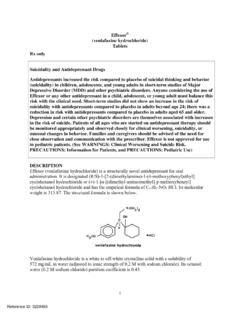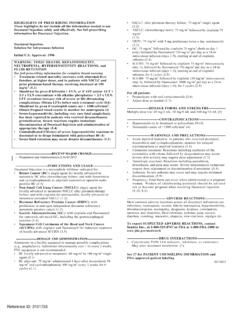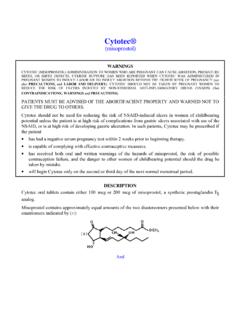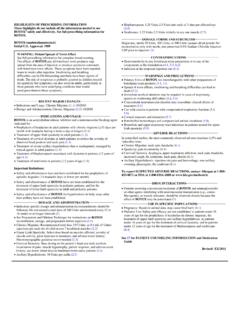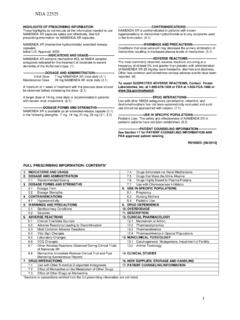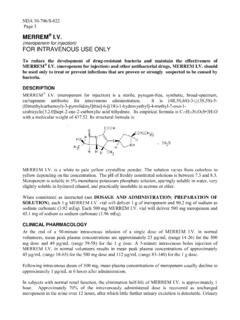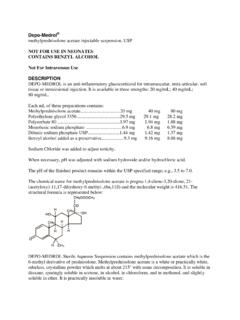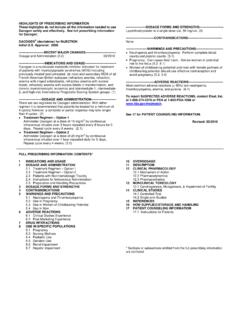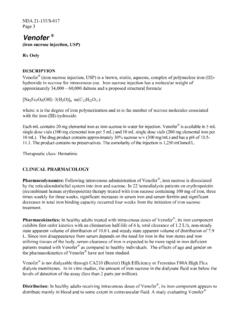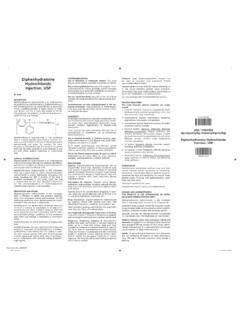Transcription of PLAQUENIL® - Food and Drug Administration
1 3 PLAQUENIL HYDROXYCHLOROQUINE SULFATE, USP WARNING PHYSICIANS SHOULD COMPLETELY FAMILIARIZE THEMSELVES WITH THE COMPLETE CONTENTS OF THIS LEAFLET BEFORE PRESCRIBING HYDROXYCHLOROQUINE. DESCRIPTION Hydroxychloroquine sulfate is a colorless crystalline solid, soluble in water to at least 20 percent; chemically the drug is 2-[[4-[(7-Chloro-4-quinolyl) amino]pentyl] ethylamino] ethanol sulfate (1:1). PLAQUENIL (hydroxychloroquine sulfate) tablets contain 200 mg hydroxychloroquine sulfate, equivalent to 155 mg base , and are for oral Administration . Inactive Ingredients: Dibasic Calcium Phosphate, Hydroxypropyl Methylcellulose, Magnesium Stearate, Polyethylene glycol 400, Polysorbate 80, Starch, Titanium Dioxide. ACTIONS The drug possesses antimalarial actions and also exerts a beneficial effect in lupus erythematosus (chronic discoid or systemic) and acute or chronic rheumatoid arthritis.
2 The precise mechanism of action is not known. INDICATIONS PLAQUENIL is indicated for the suppressive treatment and treatment of acute attacks of malaria due to Plasmodium vivax, P. malariae, P. ovale, and susceptible strains of P. falciparum. It is also indicated for the treatment of discoid and systemic lupus erythematosus, and rheumatoid arthritis. CONTRAlNDICATIONS Use of this drug is contraindicated (1) in the presence of retinal or visual field changes attributable to any 4-aminoquinoline compound, (2) in patients with known hypersensitivity to 4-aminoquinoline compounds, and (3) for long-term therapy in children. 4 WARNINGS, General PLAQUENIL is not effective against chloroquine-resistant strains of P. falciparum. Children are especially sensitive to the 4-aminoquinoline compounds.
3 A number of fatalities have been reported following the accidental ingestion of chloroquine, sometimes in relatively small doses ( g or 1 g in one 3-year-old child). Patients should be strongly warned to keep these drugs out of the reach of children. Use of PLAQUENIL in patients with psoriasis may precipitate a severe attack of psoriasis. When used in patients with porphyria the condition may be exacerbated. The preparation should not be used in these conditions unless in the judgment of the physician the benefit to the patient outweighs the possible hazard. Usage in Pregnancy Usage of this drug during pregnancy should be avoided except in the suppression or treatment of malaria when in the judgment of the physician the benefit outweighs the possible hazard.
4 It should be noted that radioactively-tagged chloroquine administered intravenously to pregnant, pigmented CBA mice passed rapidly across the placenta. It accumulated selectively in the melanin structures of the fetal eyes and was retained in the ocular tissues for five months after the drug had been eliminated from the rest of the body. PRECAUTIONS, General Antimalarial compounds should be used with caution in patients with hepatic disease or alcoholism or in conjunction with known hepatotoxic drugs. Periodic blood cell counts should be made if patients are given prolonged therapy. If any severe blood disorder appears which is not attributable to the disease under treatment, discontinuation of the drug should be considered. The drug should be administered with caution in patients having G-6-PD (glucose-6-phosphate dehydrogenase) deficiency.
5 OVERDOSAGE The 4-aminoquinoline compounds are very rapidly and completely absorbed after ingestion, and in accidental overdosage, or rarely with lower doses in hypersensitive patients, toxic symptoms may occur within 30 minutes. These consist of headache, drowsiness, visual disturbances, cardiovascular collapse, and convulsions, followed by sudden and early respiratory and cardiac arrest. The electrocardiogram may reveal atrial standstill, nodal rhythm, prolonged intraventricular conduction time, and progressive bradycardia leading to ventricular fibrillation and/or arrest. Treatment is symptomatic and must be prompt with immediate evacuation of the stomach by emesis (at home, before transportation to the hospital) or gastric lavage until the stomach is completely emptied.
6 If finely powdered, activated charcoal is introduced by the stomach tube, after lavage, and within 30 minutes after ingestion of the tablets, it may inhibit further intestinal absorption of the drug . To be effective, the dose of activated charcoal should be at least five times the estimated dose of hydroxychloroquine ingested. Convulsions, if present, should be controlled before attempting gastric lavage. If due to cerebral stimulation, cautious Administration of an ultrashort-acting barbiturate may be tried but, if due to anoxia, it should be corrected by oxygen Administration , artificial respiration or, in shock with hypotension, by vasopressor therapy. Because of the importance of supporting respiration, 5tracheal intubation or tracheostomy, followed by gastric lavage, may also be necessary.
7 Exchange transfusions have been used to reduce the level of 4-aminoquinoline drug in the blood. A patient who survives the acute phase and is asymptomatic should be closely observed for at least six hours. Fluids may be forced, and sufficient ammonium chloride (8 g daily in divided doses for adults) may be administered for a few days to acidify the urine to help promote urinary excretion in cases of both overdosage and sensitivity. Actions Like chloroquine phosphate, USP, PLAQUENIL is highly active against the erythrocytic forms of P. vivax and malariae and most strains of P. falciparum (but not the gametocytes of P. falciparum). PLAQUENIL does not prevent relapses in patients with vivax or malariae malaria because it is not effective against exo-erythrocytic forms of the parasite, nor will it prevent vivax or malariae infection when administered as a prophylactic.
8 It is highly effective as a suppressive agent in patients with vivax or malariae malaria, in terminating acute attacks, and significantly lengthening the interval between treatment and relapse. In patients with falciparum malaria, it abolishes the acute attack and effects complete cure of the infection, unless due to a resistant strain of P. falciparum. Indications PLAQUENIL is indicated for the treatment of acute attacks and suppression of malaria. Warning In recent years, it has been found that certain strains of P. falciparum have become resistant to 4-aminoquinoline compounds (including hydroxychloroquine) as shown by the fact that normally adequate doses have failed to prevent or cure clinical malaria or parasitemia. Treatment with quinine or other specific forms of therapy is therefore advised for patients infected with a resistant strain of parasites.
9 Adverse Reactions Following the Administration in doses adequate for the treatment of an acute malarial attack, mild and transient headache, dizziness, and gastrointestinal complaints (diarrhea, anorexia, nausea, abdominal cramps and, on rare occasions, vomiting) may occur. Cardiomyopathy has been rarely reported with high daily dosages of hydroxychloroquine. Dosage and Administration One tablet of 200 mg of hydroxychloroquine sulfate is equivalent to 155 mg base . Malaria: Suppression In adults, 400 mg (=310 mg base ) on exactly the same day of each week. In infants and children, the weekly suppressive dosage is 5 mg, calculated as base , per kg of body weight, but should not exceed the adult dose regardless of weight. 6If circumstances permit, suppressive therapy should begin two weeks prior to exposure.
10 However, failing this, in adults an initial double (loading) dose of 800 mg (=620 mg base ), or in children 10 mg base /kg may be taken in two divided doses, six hours apart. The suppressive therapy should be continued for eight weeks after leaving the endemic area. Treatment of the acute attack In adults, an initial dose of 800 mg (= 620 mg base ) followed by 400 mg (=310 mg base ) in six to eight hours and 400 mg (=310 mg base ) on each of two consecutive days (total 2 g hydroxychloroquine sulfate or g base ). An alternative method, employing a single dose of 800 mg (=620 mg base ), has also proved effective. The dosage for adults may also be calculated on the basis of body weight; this method is preferred for infants and children. A total dose representing 25 mg of base per kg of body weight is administered in three days, as follows: First dose: 10 mg base per kg (but not exceeding a single dose of 620 mg base ).
